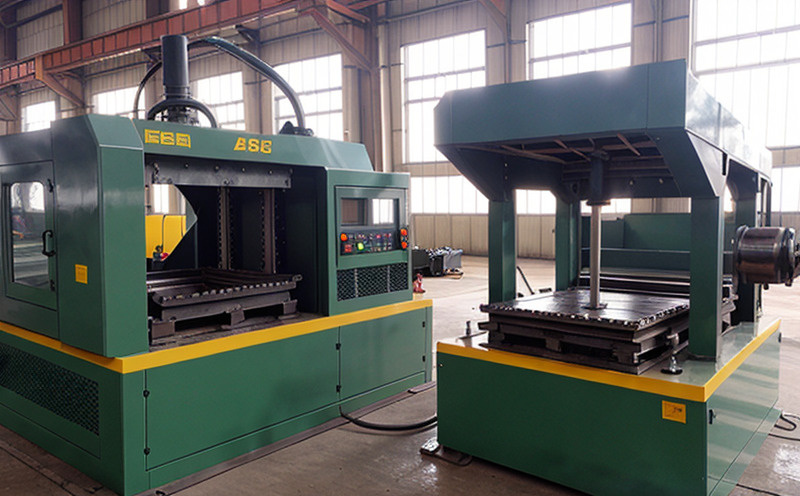ASTM A275 Magnetic Particle Testing of Forgings
The ASTM A275 standard is a widely recognized and internationally accepted method used to detect surface and near-surface defects in forgings. This non-destructive testing (NDT) technique involves applying an electromagnetic field that induces eddy currents within the material, thereby highlighting any discontinuities or flaws as visible indications on the test surface.
The process begins with a thorough preparation of the forging specimen to ensure optimal results. Cleaning and degreasing are essential steps to remove contaminants such as oil, grease, dirt, and oxides that could interfere with the testing. After cleaning, a magnetic field is generated around the component using either electromagnets or permanent magnets. The current flowing through these magnets creates an induced magnetic flux within the forging.
The next step involves applying a magnetic suspension fluid containing ferrous particles. When there's a discontinuity in the material, the magnetic flux lines are disrupted and form loops around the flaw. These loops attract the ferrous particles from the suspending fluid, resulting in visible indications on the test surface. Experienced technicians interpret these indications to determine the nature and location of any defects.
The ASTM A275 standard specifies detailed procedures for the application of magnetic flux, the type of magnetization, and the method of applying the magnetic suspension fluid. It also outlines acceptance criteria based on the size, shape, and orientation of the visible indications. Compliance with these standards ensures reliability and consistency in defect detection.
In industrial manufacturing, forging processes are crucial for producing high-strength components used in various industries such as aerospace, automotive, and construction. Ensuring the integrity and quality of forgings is paramount to prevent failures that could lead to catastrophic incidents. The ASTM A275 Magnetic Particle Testing method plays a vital role in this process by providing a reliable means to identify defects early in the production cycle.
By adhering to the ASTM A275 standard, manufacturers can ensure that their products meet stringent quality and reliability requirements. This not only enhances product performance but also boosts customer confidence and trust in the brand. The testing method’s precision and repeatability make it an indispensable tool for quality assurance teams.
Moreover, the use of this technique is supported by international standards such as ISO 9712, which provides guidelines on non-destructive testing methods. By aligning with these global standards, laboratories can offer consistent and reliable services that meet both local and international regulatory requirements.
Why It Matters
The importance of ASTM A275 Magnetic Particle Testing cannot be overstated in the context of industrial manufacturing and processing. This method serves as a critical quality control measure, ensuring that forgings are free from defects that could compromise their structural integrity.
- Prevention of Failures: Detecting and addressing defects early in the production process significantly reduces the risk of component failure during operation. Failures can lead to costly downtime, safety hazards, and reputational damage for manufacturers.
- Increase Product Lifespan: By identifying flaws before they become critical issues, the testing enhances the overall lifespan and reliability of the forged components.
- Enhanced Customer Satisfaction: Meeting stringent quality standards builds trust and satisfaction among customers, which is essential for long-term business success.
The ASTM A275 method also ensures compliance with industry-specific regulations. For instance, aerospace manufacturers must adhere to rigorous safety protocols, and magnetic particle testing plays a key role in meeting these requirements.
Furthermore, the use of this NDT technique is not limited to manufacturing processes; it extends to research and development (R&D) as well. Engineers can utilize ASTM A275 to evaluate new forging methods or materials, ensuring that any changes meet the highest quality standards.
In summary, ASTM A275 Magnetic Particle Testing is a cornerstone of industrial quality control, providing peace of mind for manufacturers and enhancing customer trust in their products.
Quality and Reliability Assurance
- Consistent Results: The ASTM A275 standard ensures that the testing method produces consistent results across different labs and technicians, thereby maintaining reliability and consistency.
- Objectivity: By following standardized procedures, subjective interpretations are minimized, leading to more objective assessments of defect presence and severity.
- Traceability: The detailed documentation required by ASTM A275 enables easy traceability of testing results, which is crucial for regulatory compliance.
- Data Accuracy: Standardized procedures ensure that the data collected during testing are accurate and reliable, supporting informed decision-making processes within manufacturing firms.
The method’s ability to detect even minute defects makes it an invaluable tool in maintaining high-quality standards. By adhering to ASTM A275, laboratories can demonstrate their commitment to quality and reliability assurance, thereby enhancing customer confidence in the services provided.
Additionally, the use of this technique supports continuous improvement efforts within manufacturing processes. Regular testing helps identify areas for process optimization, leading to enhanced efficiency and productivity.
International Acceptance and Recognition
The ASTM A275 Magnetic Particle Testing method is widely accepted and recognized across various industries globally. Its adoption by international organizations such as the International Organization for Standardization (ISO) underscores its significance in ensuring quality and reliability.
Industries like aerospace, automotive, and construction have stringent quality requirements that are met through rigorous testing methods. ASTM A275 Magnetic Particle Testing is a key component of these testing protocols, providing a reliable means to detect defects in forgings.
The method’s acceptance by international standards such as ISO 9712 further reinforces its global relevance and applicability. This standardization ensures that the testing process is consistent across different regions, facilitating seamless trade and collaboration between manufacturers worldwide.
By aligning with these international standards, laboratories can ensure that their services meet both local and international regulatory requirements. This alignment not only enhances credibility but also fosters a culture of continuous improvement in quality assurance practices.
The widespread adoption of ASTM A275 Magnetic Particle Testing reflects its importance as an essential tool for ensuring the integrity of forgings used in critical applications. Its global recognition contributes to enhanced safety and reliability in manufacturing processes across various sectors.





